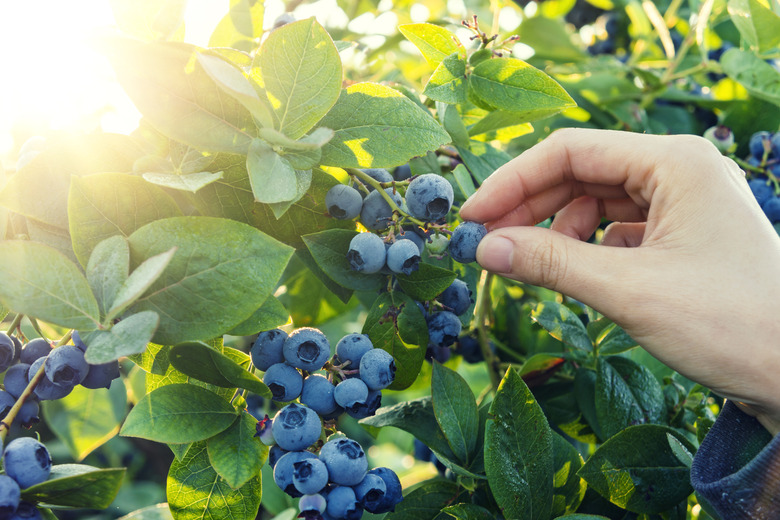How To Grow Blueberry Plants From Seed
There are good reasons gardeners typically choose to grow blueberries from cuttings or nursery shrubs — they take less time to produce blueberries and reproduce their parents' traits accurately. For the patient gardener, though, growing shrubs from blueberry seeds can be an adventure with surprising results. Choose the right type of blueberry and give it enough sun and acidic soil and you might find your name on a new variety.
Blueberry Basics for Beginners
Match the type of blueberry seeds you plant to the conditions in your garden. Wild lowbush blueberries (Vaccinium angustifolium) are hardy from U.S. Department of Agriculture plant hardiness zones 3 through 7 and plants demand between 1,000 and 1,200 chilling hours — time below 45 degrees Fahrenheit — for annual bloom and berry production. Lowbush blueberries bloom in May and June on 2-foot tall shrubs that form colonies. Highbush blueberry (Vaccinium corymbosum) bushes grow as tall as 15 feet. Northern highbush plants typically grow from USDA zones 3 through 7 and need 800 to 1,000 chilling hours annually. Southern highbush (Vaccinium corymbosum hybrid) plants are typically hardy in USDA zones 5 through 10, and require only 150 to 800 chilling hours a year. All blueberries thrive in full sun in a moist, but well-drained, sandy loam with an acidic pH of 5.5.
- There are good reasons gardeners typically choose to grow blueberries from cuttings or nursery shrubs — they take less time to produce blueberries and reproduce their parents' traits accurately.
- Wild lowbush blueberries (Vaccinium angustifolium) are hardy from U.S. Department of Agriculture plant hardiness zones 3 through 7 and plants demand between 1,000 and 1,200 chilling hours — time below 45 degrees Fahrenheit — for annual bloom and berry production.
Romancing the Seed
Blueberry cultivation takes time. Most blueberries do not self-pollinate — they need a nearby mate with similar genetic qualities to fertilize their flowers. This means blueberries are an unpredictable lot whose offspring seldom duplicate either parent. For this reason, it's usually better to purchase seeds collected by plant societies that contain known cultivars, but some prefer to harvest their own hybrids in the fall. Hold fruit in the refrigerator for several days before maceration and repeated rinsing with water. Remove floating pulp and sterile seeds with a paper towel — viable seeds sink to the bottom. Scarify seeds by placing them in damp sphagnum moss and filing them in the freezer or fridge for 90 days – that's over 2,000 chilling hours. Keep seeds refrigerated until planting time.
- Blueberry cultivation takes time.
- For this reason, it's usually better to purchase seeds collected by plant societies that contain known cultivars, but some prefer to harvest their own hybrids in the fall.
Blueberry Germination Process
After scarifying blueberry seeds in the fridge, plant blueberry seeds outdoors in the fall in warm climates and in spring in the North. For better cultural control, plant them in dampened Sphagnum peat moss in trays. Wherever you plant the seeds, cover then with only 1/4 inch of soil and keep the area continually moist. Blueberry germination can take six to eight weeks. Hybrid highbush seeds germinate more unreliably and might take longer than their wild lowbush cousins — so don't give up until 12 weeks have passed. Sprouting plants need sunny, warm conditions.
Moving Day for Blueberry Plants
After working so long for blueberry germination to take place, you will have tender sprouts. Plants will only grow 5 to 6 inches in their first year, so Northern gardeners might want to keep their plants in a sunny window during their first winter. Keep indoor trays on sunny windowsills with a florescent light mounted 14 inches above each tray to provide supplemental light. You won't know what combination of traits your plant has until it begins blooming and bearing after two or more years of growth.
- After scarifying blueberry seeds in the fridge, plant blueberry seeds outdoors in the fall in warm climates and in spring in the North.
- Plants will only grow 5 to 6 inches in their first year, so Northern gardeners might want to keep their plants in a sunny window during their first winter.
References
- U.S. Department of Agriculture: Vaccinium Angustifolium: Lowbush Blueberry
- U.S. Department of Agriculture: Highbush Blueberry Vaccinium Corymbosum
- Fall Creek Farm and Nursery: Wild Lowbush Blueberries: High Chill (also Northern Highbush, Southern Highbush and Half-Highs)
- University of Maine Cooperative Extension: Cultivated Lowbush Blueberries — Growing Blueberries From Seed
